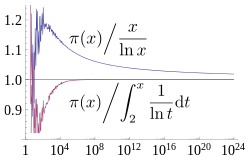Fájl:Prime number theorem ratio convergence.svg

Ennek a(z) SVG fájlnak ezen PNG formátumú előnézete: 250 × 160 képpont. További felbontások: 320 × 205 képpont | 640 × 410 képpont | 1 024 × 655 képpont | 1 280 × 819 képpont | 2 560 × 1 638 képpont.
Eredeti fájl (SVG fájl, névlegesen 250 × 160 képpont, fájlméret: 87 KB)
Fájltörténet
Kattints egy időpontra, hogy a fájl akkori állapotát láthasd.
| Dátum/idő | Bélyegkép | Felbontás | Feltöltő | Megjegyzés | |
|---|---|---|---|---|---|
| aktuális | 2013. március 21., 15:07 |  | 250 × 160 (87 KB) | Dcoetzee | Change n to x to match article |
| 2013. március 21., 14:30 |  | 250 × 160 (86 KB) | Dcoetzee | Convert formula from graphics to pure SVG using http://www.tlhiv.org/ltxpreview/ | |
| 2013. március 21., 14:23 |  | 250 × 160 (130 KB) | Dcoetzee | {{Information |Description ={{en|1=A plot showing how two estimates described by the prime number theorem, <math>\frac{n}{\ln n}</math> and <math>\int_2^n \frac{1}{\ln t} \mathrm{d}t = Li(n) = li(n) - li(2)</math> converge asymptotically towards <ma... |
Fájlhasználat
Az alábbi lap használja ezt a fájlt:
Globális fájlhasználat
A következő wikik használják ezt a fájlt:
- Használata itt: ar.wikipedia.org
- Használata itt: bn.wikipedia.org
- Használata itt: ca.wikipedia.org
- Használata itt: el.wikipedia.org
- Használata itt: en.wikipedia.org
- Használata itt: fa.wikipedia.org
- Használata itt: he.wikipedia.org
- Használata itt: hy.wikipedia.org
- Használata itt: id.wikipedia.org
- Használata itt: ja.wikipedia.org
- Használata itt: no.wikipedia.org
- Használata itt: pl.wikipedia.org
- Használata itt: sl.wikipedia.org
- Használata itt: sr.wikipedia.org
- Használata itt: sv.wikipedia.org
- Használata itt: ta.wikipedia.org
- Használata itt: vi.wikipedia.org



